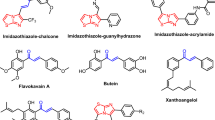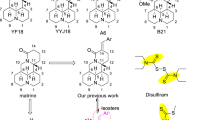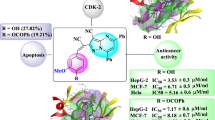Abstract
c-Met is involved in cellular processes that lead to the development and progression of cancer. A series of 2, 4-dichlorophenoxyacetamide-chalcones were synthesized and evaluated for their antiproliferative activities against MCF-7, HT-29, and A549 cancer cell lines. Several compounds showed moderate-to-good antiproliferative activity against MCF-7 and A549 cell lines. Many compounds were inactive against the HT-29 cell line. Some selected compounds were tested against c-Met kinase using the ADP GloTM assay and were found to possess IC50 < 10 µM indicating good activity. Compound 6f was identified as a promising compound and evaluated further for its antiproliferative and antimigratory properties on MCF-7 and A549 cell lines using colony formation and wound healing assays, respectively. Compound 6f had long-term antiproliferative effects and exerted antimigratory activity on both cell lines. Compound 6f had better potential at inhibiting growth and migration in MCF-7 cells. Molecular docking studies indicated that these compounds bind to Met1160 from the hinge region. Furthermore, molecular dynamics simulation studies for compound 6f confirmed this finding. Docking-based selectivity studies showed that these compounds were more selective for c-Met kinase.

Graphical abstract







Similar content being viewed by others
References
Granito A, Guidetti E, Gramantieri L. c-MET receptor tyrosine kinase as a molecular target in advanced hepatocellular carcinoma. J Hepatocell Carcinoma. 2015;2:29–38. https://doi.org/10.2147/JHC.S77038
Gentile A, Trusolino L, Comoglio PM. The Met tyrosine kinase receptor in development and cancer. Cancer Metastasis Rev. 2008;27:85–94. https://doi.org/10.1007/s10555-007-9107-6
Kim ES, Salgia R. MET pathway as a therapeutic target. J Thorac Oncol. 2009;4:444–7. https://doi.org/10.1097/JTO.0b013e31819d6f91
Zhang Y, Xia M, Jin K, Wang S, Wei H, Fan C, Wu Y, Li X, Li X, Li G, Zeng Z, Xiong W. Function of the c-Met receptor tyrosine kinase in carcinogenesis and associated therapeutic opportunities. Mol Cancer. 2018;17:45 https://doi.org/10.1186/s12943-018-0796-y
Ghiso E, Giordano S. Targeting MET: why, where and how. Curr Opin Pharm. 2013;13:511–8. https://doi.org/10.1016/j.coph.2013.05.018
Fu J, Su X, Li Z, Deng L, Liu X, Feng X, Peng J. HGF/c-MET pathway in cancer: from molecular characterization to clinical evidence. Oncogene. 2021;40:4625–51. https://doi.org/10.1038/s41388-021-01863-w
Parikh PK, Ghate MD. Recent advances in the discovery of small molecule c-Met Kinase inhibitors. Eur J Med Chem. 2018;143:1103–38. https://doi.org/10.1016/j.ejmech.2017.08.044
Ko B, He T, Gadgeel S, Halmos B. MET/HGF pathway activation as a paradigm of resistance to targeted therapies. Ann Transl Med. 2017;5:4. https://doi.org/10.21037/atm.2016.12.09
Botting GM, Rastogi I, Chhabra G, Nlend M, Puri N. Mechanism of resistance and novel targets mediating resistance to EGFR and c-Met tyrosine kinase inhibitors in non-small cell lung cancer. PLoS One. 2015;10:e0136155. https://doi.org/10.1371/journal.pone.0136155
Constantinescu T, Lungu CL. Anticancer activity of natural and synthetic chalcones. Int J Mol Sci. 2021;22:11306 https://doi.org/10.3390/ijms222111306
Oh HN, Lee MH, Kim E, Yoon G, Chae JI, Shim JH. Licochalcone B inhibits growth and induces apoptosis of human non-small-cell lung cancer cells by dual targeting of EGFR and MET. Phytomedicine. 2019;63:153014. https://doi.org/10.1016/j.phymed.2019.153014
Jung SK, Lee MH, Lim DY, Lee SY, Jeong CH, Kim JE, Lim TG, Chen H, Bode AM, Lee HJ, Lee KW, Dong Z. Butein, a novel dual inhibitor of MET and EGFR, overcomes gefitinib-resistant lung cancer growth. Mol Carcinog. 2015;54:322–31. https://doi.org/10.1002/mc.22191
Salehi B, Varoni EM, Sharifi-Rad M, Rajabi S, Zucca P, Iriti M, Sharifi-Rad J. Epithelial-mesenchymal transition as a target for botanicals in cancer metastasis. Phytomedicine. 2019;55:125–36. https://doi.org/10.1016/j.phymed.2018.07.001
Oh HN, Lee MH, Kim E, Kwak AW, Yoon G, Cho SS, Liu K, Chae JI, Shim JH. Licochalcone D induces ROS-dependent apoptosis in gefitinib-sensitive or resistant lung cancer cells by targeting EGFR and MET. Biomolecules. 2020;10:297. https://doi.org/10.3390/biom10020297
Purnama A, Mardina V, Puspita K, et al. Molecular docking of two cytotoxic compounds from Calotropis gigantea leaves against therapeutic molecular target of pancreatic cancer. Narra J. 2021;1. https://doi.org/10.52225/narraj.v1i2.37
Begum S, Bharathi K, Prasad KVSRG. Mini review on therapeutic profile of phenoxy acids and thier derivatives. Int J Pharm Pharm Sci. 2016;8:66–71. https://doi.org/10.22159/ijpps.2016v8i10.5005
Rani P, Pal D, Hegde RR, Hashim SR. Leuckart synthesis and pharmacological assessment of novel acetamide derivatives. Anticancer Agents Med Chem. 2016;16:898–906. https://doi.org/10.2174/1871520616666151111115327
Patil V, Tilekar K, Mehendale-Munj S, Mohan R, Ramaa CS. Synthesis and primary cytotoxicity evaluation of new 5-benzylidene-2,4-thiazolidinedione derivatives. Eur J Med Chem. 2010;45:4539–44. https://doi.org/10.1016/j.ejmech.2010.07.014
Bhanushali U, Rajendran S, Sarma K, Kulkarni P, Chatti K, Chatterjee S, Ramaa CS. 5-Benzylidene-2,4-thiazolidenedione derivatives: design, synthesis and evaluation as inhibitors of angiogenesis targeting VEGR-2. Bioorg Chem. 2016;67:139–47. https://doi.org/10.1016/j.bioorg.2016.06.006
Prabhakar BT, Khanum SA, Shashikanth S, Salimath BP. Antiangiogenic effect of 2-benzoyl-phenoxy acetamide in EAT cell is mediated by HIF-1 alpha and down regulation of VEGF of in-vivo. Investig N Drugs. 2006;24:471–78. https://doi.org/10.1007/s10637-006-6587-0
Wang C, Gao H, Dong J, Wang F, Li P, Zhang J. Insight into the medicinal chemistry of EGFR and HER-2 inhibitors. Curr Med Chem. 2014;21:1336–50. https://doi.org/10.2174/0929867320666131119124646
Lee K, Roh SH, Xia Y, Kang KW. Synthesis and biological evaluation of phenoxy-N-phenylacetamide derivatives as novel P-glycoprotein inhibitors. Bull Korean Chem Soc. 2011;32:3666–74. https://doi.org/10.5012/bkcs.2011.32.10.3666
Jung SK, Lee MH, Lim DY, Lee SY, Jeong CH, Kim JE, Lim TG, Chen H, Bode AM, Lee HJ, Lee KW. Butein, a novel dual inhibitor of MET and EGFR, overcomes gefitinib‐resistant lung cancer growth. Mol Carcinog. 2015;54:322–31. https://doi.org/10.1002/mc.22191
Joshi A, Bhojwani H, Wagal O, Begwani K, Joshi U, Sathaye S, Kanchan D. Evaluation of benzamide-chalcone derivatives as EGFR/CDK2 inhibitor: synthesis, in-vitro inhibition, and molecular modeling studies. Anticancer Agents Med Chem. 2022;22:328–43. https://doi.org/10.2174/1871520621666210415091359
Karthikeyan C, Narayana Moorthy NSH, Ramasamy S, Vanam U, Manivannan E, Karunagaran D, Trivedi P. Advances in chalcones with anticancer activities. Recent Pat Anticancer Drug Discov 2014;10:97–115
Silverstein RM, Webster FX. Spectrometric identification of organic compounds, 6th ed. 2006
Parr C, Jiang WG. Expression of hepatocyte growth factor/scatter factor, its activator, inhibitors and the c-Met receptor in human cancer cells. Int J Oncol. 2001;19:857–63. https://doi.org/10.3892/ijo.19.4.857
Wang J, Anderson MG, Oleksijew A, Vaidya KS, Boghaert ER, Tucker L, Zhang Q, Han EK, Palma JP, Naumovski L, Reilly EB. ABBV-399, a c-Met antibody-drug conjugate that targets both MET-amplified and c-Met-overexpressing tumors, irrespective of MET pathway dependence. Clin Cancer Res. 2017;23:992–1000. https://doi.org/10.1158/1078-0432.CCR-16-1568
Kammula US, Kuntz EJ, Francone TD, Zeng Z, Shia J, Landmann RG, Paty PB, Weiser MR. Molecular co-expression of the c-Met oncogene and hepatocyte growth factor in primary colon cancer predicts tumor stage and clinical outcome. Cancer Lett. 2007;248:219–28. https://doi.org/10.1016/j.canlet.2006.07.007
Liu Y, Shi QF, Qi M, Tashiro S, Onodera S, Ikejima T. Interruption of hepatocyte growth factor signaling augmented oridonin-induced death in human non-small cell lung cancer A549 cells via c-met-nuclear factor-κB-cyclooxygenase-2 and c-Met-Bcl-2-caspase-3 pathways. Biol Pharm Bull. 2012;35:1150–58. https://doi.org/10.1248/bpb.b12-00197
Ma PC, Jagadeeswaran R, Jagadeesh S, Tretiakova MS, Nallasura V, Fox EA, Hansen M, Schaefer E, Naoki K, Lader A, Richards W, Sugarbaker D, Husain AN, Christensen JG, Salgia R. Functional expression and mutations of c-Met and its therapeutic inhibition with SU11274 and small interfering RNA in non-small cell lung cancer. Cancer Res. 2005;65:1479–88. https://doi.org/10.1158/0008-5472.CAN-04-2650
Humphrey PA, Zhu X, Zarnegar R, Swanson PE, Ratliff TL, Vollmer RT, Day ML. Hepatocyte growth factor and its receptor (c-MET) in prostatic carcinoma. Am J Pathol. 1995;147:386–96.
Wu JF, Liu MM, Huang SX, Wang Y. Design and synthesis of novel substituted naphthyridines as potential c-Met kinase inhibitors based on MK-2461. Bioorg Med Chem Lett. 2015;25:3251–55. https://doi.org/10.1016/j.bmcl.2015.05.082
Yang Y, Zhang Y, Yang L, Zhao L, Si L, Zhang H, Liu Q, Zhou J. Discovery of imidazopyridine derivatives as novel c-Met kinase inhibitors: Synthesis, SAR study, and biological activity. Bioorg Chem. 2017;70:126–32. https://doi.org/10.1016/j.bioorg.2016.12.002
Zhai X, Bao G, Wang L, Cheng M, Zhao M, Zhao S, Zhou H, Gong P. Design, synthesis and biological evaluation of novel 4-phenoxy-6,7-disubstituted quinolines possessing (thio)semicarbazones as c-Met kinase inhibitors. Bioorg Med Chem. 2016;24:1331–45. https://doi.org/10.1016/j.bmc.2016.02.003
Liu J, Yang D, Yang X, Nie M, Wu G, Wang Z, Li W, Liu Y, Gong P. Design, synthesis and biological evaluation of novel 4-phenoxyquinoline derivatives containing 3-oxo-3,4-dihydroquinoxaline moiety as c-Met kinase inhibitors. Bioorg Med Chem. 2017;25:4475–86. https://doi.org/10.1016/j.bmc.2017.06.037
Wang LX, Liu X, Xu S, Tang Q, Duan Y, Xiao Z, Zhi J, Jiang L, Zheng P, Zhu W. Discovery of novel pyrrolo-pyridine/pyrimidine derivatives bearing pyridazinone moiety as c-Met kinase inhibitors. Eur J Med Chem. 2017;141:538–51. https://doi.org/10.1016/j.ejmech.2017.10.027
Yuan H, Liu Q, Zhang L, Hu S, Chen T, Li H, Chen Y, Xu Y, Lu T. Discovery, optimization and biological evaluation for novel c-Met kinase inhibitors. Eur J Med Chem. 2018;143:491–502. https://doi.org/10.1016/j.ejmech.2017.11.073
Tacar O, Sriamornsak P, Dass CR. Doxorubicin: an update on anticancer molecular action, toxicity and novel drug delivery systems. J Pharm Pharm. 2013;65:157–70. https://doi.org/10.1111/j.2042-7158.2012.01567.x
Joshi A, Bhojwani H, Joshi U, et al. Cinnamamide‑chalcone derivatives as CDK2 inhibitors: synthesis, pharmacological evaluation, and molecular modelling study. J Iran Chem Soc. 2022. https://doi.org/10.1007/s13738-022-02610-y
Xiong H, Zhang J, Zhang Q, Duan Y, Zhang H, Zheng P, Tang Q. Design, synthesis and biological evaluation of 4-(pyridin-4-yloxy) benzamide derivatives bearing a 5-methylpyridazin-3(2H)-one fragment. Bioorg Med Chem Lett. 2020;30:127076 https://doi.org/10.1016/j.bmcl.2020.127076
Chen X, Zhang B, Yuan X, Yang F, Liu J, Zhao H, Liu L, Wang Y, Wang Z, Zheng Q. Isoliquiritigenin-induced differentiation in mouse melanoma B16F0 cell line. Oxid Med Cell Longev. 2012;2012:534934 https://doi.org/10.1155/2012/534934
Rodriguez LG, Wu X, Guan JL. Wound-healing assay. Methods Mol Biol. 2005;294:23–9. https://doi.org/10.1385/1-59259-860-9:023
Younus S, Chandra SSV, Nair SSA. Docking and dynamic simulation study of crizotinib and temozolomide drug with glioblastoma and NSCLC target to identify better efficacy of the drug. Futur J Pharm Sci. 2021;7:187 https://doi.org/10.1186/s43094-021-00323-2
Schiering N, Knapp S, Marconi M, Flocco MM, Cui J, Perego R, Rusconi L, Cristiani C. Crystal structure of the tyrosine kinase domain of the hepatocyte growth factor receptor c-Met and its complex with the microbial alkaloid K-252a. PNAS. 2003;100:12654–9. https://doi.org/10.1073/pnas.1734128100
Sarukhanyan E, Shityakov S, Dandekar T. In silico designed Axl receptor blocking drug candidates against Zika virus infection. ACS Omega. 2018;3:5281–90. https://doi.org/10.1021/acsomega.8b00223
Nwizu T, Kanteti R, Kawada I, Rolle C, Vokes EE, Salgia R. Crizotinib (PF02341066) as a ALK/MET inhibitor—special emphasis as a therapeutic drug against lung cancer. Drugs Future. 2011;36:91–9. https://doi.org/10.1358/dof.2011.036.02.1584112
Zhu C, Wei Y, Wei X. AXL receptor tyrosine kinase as a promising anti-cancer approach: functions, molecular mechanisms and clinical applications. Mol Cancer. 2019;18:1–22. https://doi.org/10.1186/s12943-019-1090-3
Yakes FM, Chen J, Tan J, Yamaguchi K, Shi Y, Yu P, Qian F, Chu F, Bentzien F, Cancilla B, Orf J, You A, Laird AD, Engst S, Lee L, Lesch J, Chou YC, Joly AH. Cabozantinib (XL184), a novel MET and VEGFR2 inhibitor, simultaneously suppresses metastasis, angiogenesis, and tumor growth. Mol Cancer Ther 2011;10:2298–308. https://doi.org/10.1158/1535-7163.MCT-11-0264
Damghani T, Sedghamiz T, Sharifi S, Pirhadi S. Critical c-Met-inhibitor interactions resolved from molecular dynamics simulations of different c-Met complexes. J Mol Str. 2020;1203:127456 https://doi.org/10.1016/j.molstruc.2019.127456
Morgan E. Vogel’s textbook of practical organic chemistry, 5th ed. 1990
Bhagat S, Sharma R, Sawant DM, Sharma L, Chakraborti AK. LiOH·H2O as a novel dual activation catalyst for highly efficient and easy synthesis of 1,3-diaryl-2-propenones by Claisen–Schmidt condensation under mild conditions. J Mol Catal A Chem. 2006;244:20–4. https://doi.org/10.1016/j.molcata.2005.08.039
Papazisis KT, Geromichalos GD, Dimitriadis KA, Kortsaris AH. Optimization of the sulforhodamine B colorimetric assay. J Immunol Methods. 1997;208:151–8. https://doi.org/10.1016/s0022-1759(97)00137-3
Voigt W. Sulforhodamine B assay and chemosensitivity. Methods Mol Med. 2005;110:39–48. https://doi.org/10.1385/1-59259-869-2:039
Hsiao BK, Zegzouti H, Ph D, Vidugiriene J, Goueli SA. Corporation P. MET Kinase Assay. 1989
TM313. ADP-Glo TM Kinase Assay. Technical Manual, Promega Corporation.
Corporation P. ADP-Glo Kinase Assay: Instructions for Use of Products V9101, V9102 and V9103. 2011, Revised 3/(TM313), 22
Zegzouti H, Zdanovskaia M, Hsiao K, Goueli SA. ADP-Glo: a bioluminescent and homogeneous ADP monitoring assay for kinases. Assay Drug Dev Technol. 2009;7:560–72. https://doi.org/10.1089/adt.2009.0222
Wagal OS, Joshi AJ, Joshi UJ, Bhojwani HR, Begwani KV, Dawne HA, Gude RP, Sathaye SS, Kanchan DM. Studies in molecular modeling, in-vitro CDK2 inhibition and antimetastatic activity of some synthetic flavones. Front Biosci (Landmark Ed). 2021;26:664–81. https://doi.org/10.2741/4911
Franken NA, Rodermond HM, Stap J, Haveman J, van Bree C. Clonogenic assay of cells in vitro. Nat Protoc. 2006;1:2315–9. https://doi.org/10.1038/nprot.2006.339
Lee HS, Seo EY, Kang NE, Kim WK. [6]-Gingerol inhibits metastasis of MDA-MB-231 human breast cancer cells. J Nutr Biochem. 2008;19:313–9. https://doi.org/10.1016/j.jnutbio.2007.05.008
Pichot CS, Hartig SM, Xia L, Arvanitis C, Monisvais D, Lee FY, Frost JA, Corey SJ. Dasatinib synergizes with doxorubicin to block growth, migration, and invasion of breast cancer cells. Br J Cancer. 2009;101:38–47. https://doi.org/10.1038/sj.bjc.6605101
Maestro, version 11.1, Schrodinger, LLC, New York, NY, 2017.
Schrödinger Release 2017-1: Protein Preparation Wizard; Epik, Schrödinger, LLC, New York, NY, 2017; Impact, Schrödinger, LLC, New York, NY, 2017; Prime, Schrödinger, LLC, New York, NY, 2017
Sastry GM, Adzhigirey M, Day T, Annabhimoju R, Sherman W. Protein and ligand preparation: parameters, protocols, and influence on virtual screening enrichments. J Comput Aided Mol Des. 2013;27:221–34. https://doi.org/10.1007/s10822-013-9644-8
Schrodinger Release 2017-1: Glide, Schrodinger, LLC, New York, NY, 2017
Schrodinger Release 2017-1: Ligprep, Schrodinger, LLC, New York, NY, 2017
Friesner RA, Banks JL, Murphy RB, Halgren TA, Klicic JJ, Mainz DT, Repasky MP, Knoll EH, Shelley M, Perry JK, Shaw DE, Francis P, Shenkin PS. Glide: a new approach for rapid, accurate docking and scoring. 1. Method and assessment of docking accuracy. J Med Chem. 2004;47:1739–49. https://doi.org/10.1021/jm0306430
Friesner RA, Murphy RB, Repasky MP, Frye LL, Greenwood JR, Halgren TA, Sanschagrin PC, Mainz DT. Extra precision glide: Docking and scoring incorporating a model of hydrophobic enclosure for protein-ligand complexes. J Med Chem. 2006;49:6177–96
Desmond molecular dynamics system; D. E. Shaw Research: New York, NY, 2018
Bowers KJ, Chow E, Xu H, et al. Scalable algorithms for molecular dynamics simulations on commodity clusters. In Proceedings of the 2006 ACM/IEEE conference on supercomputing 2006 (pp. 84-es). https://doi.org/10.1109/SC.2006.54
Jorgensen WL, Chandrasekhar J, Madura JD, Impey RW, Klein ML. Comparison of simple potential functions for simulating liquid water. J Chem Phys. 1983;79:926–35. https://doi.org/10.1063/1.445869
Ryckaert JP, Ciccotti G, Berendsen HJ. Numerical integration of the cartesian equations of motion of a system with constraints: molecular dynamics of n-alkanes. J Comput Phys. 1977;23:327–41. https://doi.org/10.1016/0021-9991(77)90098-5
Lambrakos SG, Boris JP, Oran ES, Chandrasekhar I, Nagumo M. A modified shake algorithm for maintaining rigid bonds in molecular dynamics simulations of large molecules. J Comput Phys. 1989;85:473–86. https://doi.org/10.1016/0021-9991(89)90160-5
Tuckerman MB, Berne BJ, Martyna GJ. Reversible multiple time scale molecular dynamics. J Chem Phys. 1992;97:1990–2001. https://doi.org/10.1063/1.463137
Martyna GJ, Tobias DJ, Klein ML. Constant pressure molecular dynamics algorithms. J Chem Phys. 1994;101:4177–89. https://doi.org/10.1063/1.467468
Talele TT, McLaughlin ML. Molecular docking/dynamics studies of Aurora A kinase inhibitors. J Mol Graph Model. 2008;26:1213–22. https://doi.org/10.1016/j.jmgm.2007.11.003
Qureshi SI, Chaudhari HK. Design, synthesis, in-silico studies and biological screening of quinazolinone analogues as potential antibacterial agents against MRSA. Bioorg Med Chem 2019;27:2676–88. https://doi.org/10.1016/j.bmc.2019.05.012
Acknowledgements
This study was funded by Indian Council of Medical Research (ICMR) under Senior Research Fellowship (F. No.45/18/201/-BIO/BMS dated 11th April 2018) awarded to Ms. Heena Bhojwani. Dr. Urmila Joshi acknowledges Department of Science and Technology- SERB (SERB/F/7466/2018-2019) and All India Council for Technical Education (F. No. 8-36/RIFD/RPS/Policy-1/2017-18 dated 4th January 2019) for research facilities. Ms. Heena Bhojwani acknowledges the FTIR facility rendered to her under the DST-FIST Grant (Letter SR/FST/College-264 dated 18th November 2015) and Instrumentation Facility at University of Mumbai for NMR. Authors acknowledge Dr. Anindya Goswami, Cancer Pharmacology Division, CSIR-IIIM, Jammu for the assistance in colony formation and wound healing assay. Authors are thankful to Dr. Jyoti Kode, ACTREC, Kharghar for their anticancer drug screening facility. Authors acknowledge Ms. Khushboo Begwani for helping in kinase inhibition assay. Authors are thankful to Cipla Pvt. Ltd. Mumbai for the drug sorafenib provided as gift sample. Authors acknowledge D. E. Shaw Pvt. Ltd. for academic version of Desmond.
Author information
Authors and Affiliations
Corresponding author
Ethics declarations
Conflict of interest
The authors declare no competing interests.
Additional information
Publisher’s note Springer Nature remains neutral with regard to jurisdictional claims in published maps and institutional affiliations.
Supplementary information
Rights and permissions
Springer Nature or its licensor (e.g. a society or other partner) holds exclusive rights to this article under a publishing agreement with the author(s) or other rightsholder(s); author self-archiving of the accepted manuscript version of this article is solely governed by the terms of such publishing agreement and applicable law.
About this article
Cite this article
Bhojwani, H., Patil, S., Joshi, U. et al. Design, synthesis, and biological evaluation of 2, 4-dichlorophenoxyacetamide chalcone hybrids as potential c-Met kinase inhibitors. Med Chem Res 32, 109–127 (2023). https://doi.org/10.1007/s00044-022-02986-9
Received:
Accepted:
Published:
Issue Date:
DOI: https://doi.org/10.1007/s00044-022-02986-9




